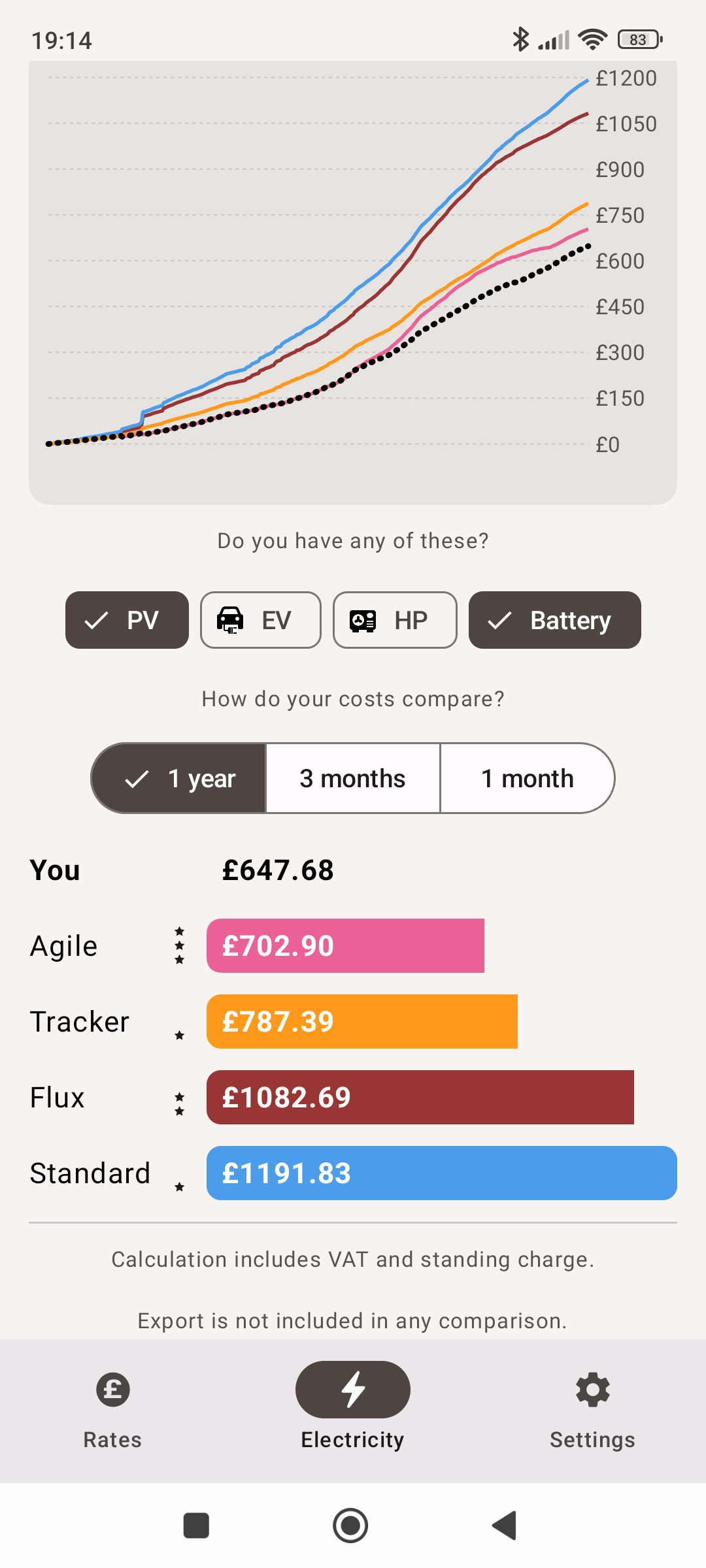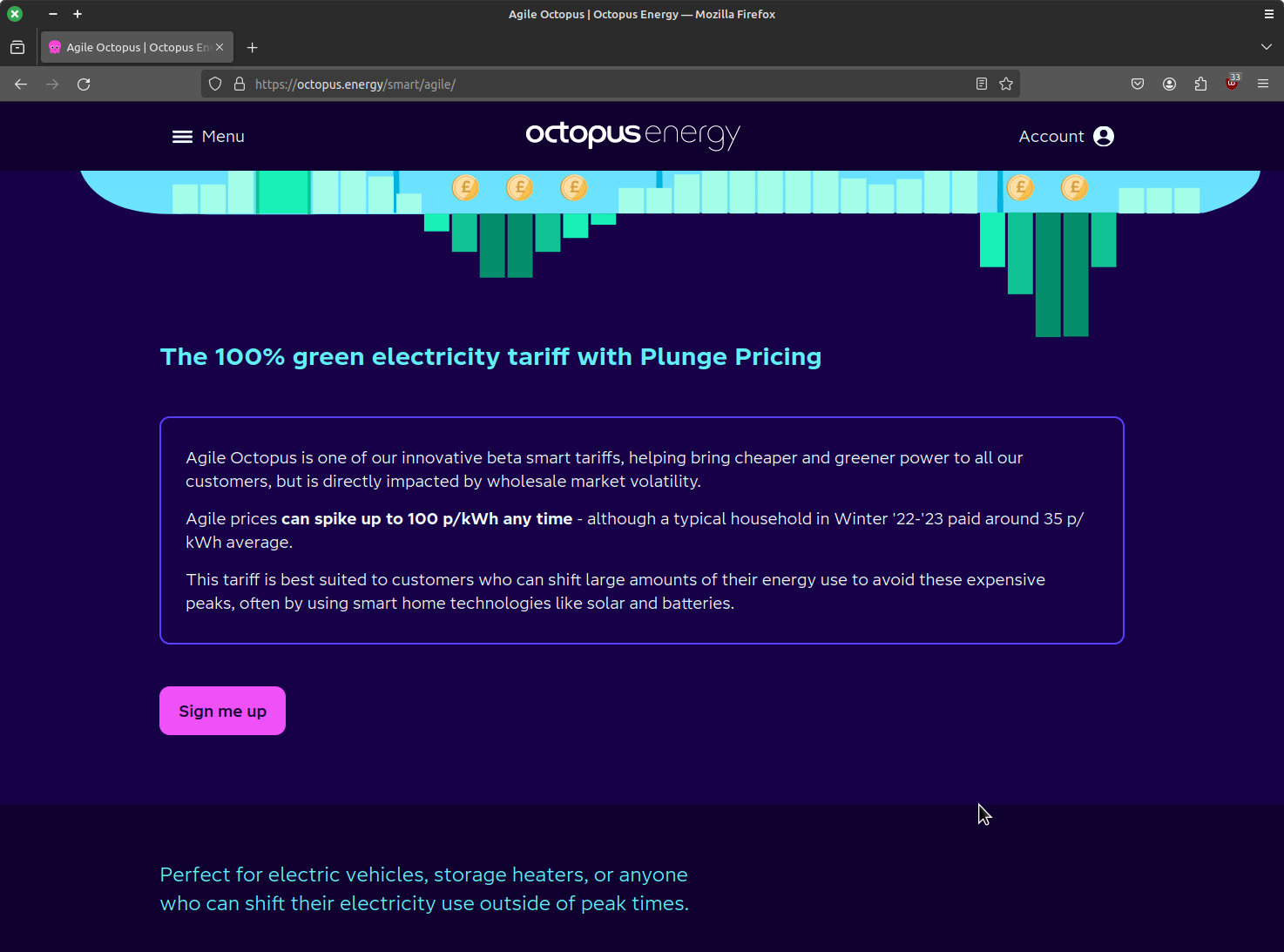We’d like to remind Forumites to please avoid political debate on the Forum.
This is to keep it a safe and useful space for MoneySaving discussions. Threads that are – or become – political in nature may be removed in line with the Forum’s rules. Thank you for your understanding.
Very pushy replacement energy meter calls
Comments
-
prowla said:I took a look at Octopus' Agile offering and they say:
Agile Octopus is one of our innovative beta smart tariffs, helping bring cheaper and greener power to all our customers, but is directly impacted by wholesale market volatility.
Agile prices can spike up to 100 p/kWh any time - although a typical household in Winter '22-'23 paid around 35 p/kWh average.
This tariff is best suited to customers who can shift large amounts of their energy use to avoid these expensive peaks, often by using smart home technologies like solar and batteries.
That 35p/kWh dosn't seem very attractive?Also, I don't have a battery, so couldn't do that shift to charge it during cheaper times.This screenshot from the Octopus Watch app taken just now might be of interest. It shows import only and compares what I actually paid over the last 12 months and what I would have paid on various Octopus tarriffs. The one that may be of most interest to you is Tracker which doesn't need any load shifting and still shows a £400+ saving over the standard variable rate. 1
1 -
BarelySentientAI said:
The OFGEM price cap at that time was between 33.7p and 38.3p depending on region, so it was still not expensive.prowla said:I took a look at Octopus' Agile offering and they say:Agile Octopus is one of our innovative beta smart tariffs, helping bring cheaper and greener power to all our customers, but is directly impacted by wholesale market volatility.
Agile prices can spike up to 100 p/kWh any time - although a typical household in Winter '22-'23 paid around 35 p/kWh average.
This tariff is best suited to customers who can shift large amounts of their energy use to avoid these expensive peaks, often by using smart home technologies like solar and batteries.
That 35p/kWh dosn't seem very attractive?Also, I don't have a battery, so couldn't do that shift to charge it during cheaper times.
Yes - not expensive, but not quite the 20-30% savings which have been mentioned.
0 -
Just the same as knowing there are two petrol stations, one 10p cheaper than the other, but not being bothered to drive the extra half-mile to the cheaper one. That's no fault or failing of the tariffs and isn't a valid argument against them.prowla said:BarelySentientAI said:
The OFGEM price cap at that time was between 33.7p and 38.3p depending on region, so it was still not expensive.prowla said:I took a look at Octopus' Agile offering and they say:Agile Octopus is one of our innovative beta smart tariffs, helping bring cheaper and greener power to all our customers, but is directly impacted by wholesale market volatility.
Agile prices can spike up to 100 p/kWh any time - although a typical household in Winter '22-'23 paid around 35 p/kWh average.
This tariff is best suited to customers who can shift large amounts of their energy use to avoid these expensive peaks, often by using smart home technologies like solar and batteries.
That 35p/kWh dosn't seem very attractive?Also, I don't have a battery, so couldn't do that shift to charge it during cheaper times.
Yes - not expensive, but not quite the 20-30% savings which have been mentioned.1 -
[Deleted User] said:prowla said:I took a look at Octopus' Agile offering and they say:
Agile Octopus is one of our innovative beta smart tariffs, helping bring cheaper and greener power to all our customers, but is directly impacted by wholesale market volatility.
Agile prices can spike up to 100 p/kWh any time - although a typical household in Winter '22-'23 paid around 35 p/kWh average.
This tariff is best suited to customers who can shift large amounts of their energy use to avoid these expensive peaks, often by using smart home technologies like solar and batteries.
That 35p/kWh dosn't seem very attractive?Also, I don't have a battery, so couldn't do that shift to charge it during cheaper times.This screenshot from the Octopus Watch app taken just now might be of interest. It shows import only and compares what I actually paid over the last 12 months and what I would have paid on various Octopus tarriffs. The one that may be of most interest to you is Tracker which doesn't need any load shifting and still shows a £400+ saving over the standard variable rate. That's an interesting graph - very useful info!As commented, they do say the Agile tariff is designed for users with batteries who can save by charging off-peak.You've got solar and battery, so i would expect your readings to be significanty lower than I might achieve with neither.I'm not in a position to have either of those, so we're somewhat comparing apples and pears.0
That's an interesting graph - very useful info!As commented, they do say the Agile tariff is designed for users with batteries who can save by charging off-peak.You've got solar and battery, so i would expect your readings to be significanty lower than I might achieve with neither.I'm not in a position to have either of those, so we're somewhat comparing apples and pears.0 -
As commented, they do say the Agile tariff is designed for users with batteries who can save by charging off-peak.
That isn't true. I don't have batteries or solar and I paid an average of just over 9p/kWh for my last billing period. The highest average I've ever paid on Agile is under 20p, and that was when the SVT was about 30p, so a 33% saving.
0 -
Spoonie_Turtle said:
As far as I'm aware the fallback for Agile is billing based on the SVT. What you describe sounds like what they do for Tracker, using an industry formula to apportion usage across the days between readings.Chrysalis said:Spoonie_Turtle said:
I believe that is almost the case for Tracker. As long as it communicates with Octopus to start with, if it then fails they don't boot you off the tariff because half-hourly data isn't necessary to bill like it is for Agile.MP1995 said:
However, when you have one fitted, I believe you should get cheaper rates even if it is not communicating as effectively as required. Might not be the exact savings of 30 min load shifting that some can do but once fitted it should be able to say take advantage of a tariff like tracker with manual readings sent if necessary.Marvel1 said:
Surely a smart meter is meant to do what it is suppose to do and send regular readings through out the day to save money in the first place.MP1995 said:We have become a greener user of electricity since changing to Agile.
This benefits the world and also in turn benefits us with really cheap electricity like 10-12p kwh......pre price hike(s) prices.
I do find these anti smart meter posts funny but am happy for those that don't want one to carry on.
However......... do this somewhere else.........this is a money saving site and surely the money saving option is to get a smart meter?
(And with them being consistently inconsistent, someone with a smart meter fitted that doesn't communicate from the start might think it worth asking to join Tracker anyway, on the off-chance an individual rep might agree with the principle of it … )
I think even Agile has a fallback, I remember reading on the Octopus website that when 30 minute data is not available they will assume a certain usage spread based on common usage pattern.I recall what I read very clearly, there is/was a graph on their website which they use as kind of a emulated usage pattern if they dont have access to the 30 minute data. So they take the daily usage and then apply a certain % of it for each slot, with most of it going to peak hours.There would be no point on the tracker as the tracker is not a TOU tariff, it doesnt matter what time of day you use the energy.I just spent 5 minutes to see if I could find the page but cannot, so it may have changed now or its just a pain to find the information.0 -
prowla said:BarelySentientAI said:
The OFGEM price cap at that time was between 33.7p and 38.3p depending on region, so it was still not expensive.prowla said:I took a look at Octopus' Agile offering and they say:Agile Octopus is one of our innovative beta smart tariffs, helping bring cheaper and greener power to all our customers, but is directly impacted by wholesale market volatility.
Agile prices can spike up to 100 p/kWh any time - although a typical household in Winter '22-'23 paid around 35 p/kWh average.
This tariff is best suited to customers who can shift large amounts of their energy use to avoid these expensive peaks, often by using smart home technologies like solar and batteries.
That 35p/kWh dosn't seem very attractive?Also, I don't have a battery, so couldn't do that shift to charge it during cheaper times.
Yes - not expensive, but not quite the 20-30% savings which have been mentioned.At one point it was closer to 50% savings, Octopus seem to undersell the tariffs.Also for reference I am currently on Agile and was on it prior as well, and dont actively load shift, just use my energy normally and save money over tracker, and much bigger amounts over SVR/SVT.1 -
I'm sure their facebook ads state "up to 70% savings".Chrysalis said:prowla said:BarelySentientAI said:
The OFGEM price cap at that time was between 33.7p and 38.3p depending on region, so it was still not expensive.prowla said:I took a look at Octopus' Agile offering and they say:Agile Octopus is one of our innovative beta smart tariffs, helping bring cheaper and greener power to all our customers, but is directly impacted by wholesale market volatility.
Agile prices can spike up to 100 p/kWh any time - although a typical household in Winter '22-'23 paid around 35 p/kWh average.
This tariff is best suited to customers who can shift large amounts of their energy use to avoid these expensive peaks, often by using smart home technologies like solar and batteries.
That 35p/kWh dosn't seem very attractive?Also, I don't have a battery, so couldn't do that shift to charge it during cheaper times.
Yes - not expensive, but not quite the 20-30% savings which have been mentioned.
At one point it was closer to 50% savings, Octopus seem to undersell the tariffs.0 -
Talking about averages and percentages often doesn’t hold a great deal of meaning when discussing energy tariffs due to all the different variables between people and regions. This is especially true in the case of tariffs like Agile and Tracker where the number of variables is even greater.
I’m confident you could pick practically any percentage to use as the “savings” figure and it would still be true and supported by factual data on some level. It’s all entirely dependent on what data you view, what you’re comparing it to, and which assumptions you choose to make.
By far the simplest way of determining actual possible savings on a smart tariff is to use one of the various services that do just that with your actual usage data, such as the app mentioned a few posts up. Then there’s no, marketing noise, inequivalent comparisons, or regional variations because it’s your real usage data being used.These typically take mere minutes to set up with a functioning smart meter and will show exactly what your past usage would have cost on your tariff of choice without any of the guesswork or speculations.I like Octopus Compare myself, as it’s relatively simple and gives an accurate at-a-glance view of my Agile usage cost compared to the tariff I would otherwise be on now. So far Agile has worked out cheaper on every single day since I made the switch, usually by quite a significant margin.Moo…1 -
Netexporter said:As commented, they do say the Agile tariff is designed for users with batteries who can save by charging off-peak.
That isn't true. I don't have batteries or solar and I paid an average of just over 9p/kWh for my last billing period. The highest average I've ever paid on Agile is under 20p, and that was when the SVT was about 30p, so a 33% saving.
I checked and misquoted their site; it says "best suited", not "designed for" and mentions shifting usage along with solar and batteries:
0
Confirm your email address to Create Threads and Reply

Categories
- All Categories
- 352.9K Banking & Borrowing
- 253.9K Reduce Debt & Boost Income
- 454.7K Spending & Discounts
- 246K Work, Benefits & Business
- 602.1K Mortgages, Homes & Bills
- 177.8K Life & Family
- 259.9K Travel & Transport
- 1.5M Hobbies & Leisure
- 16K Discuss & Feedback
- 37.7K Read-Only Boards





